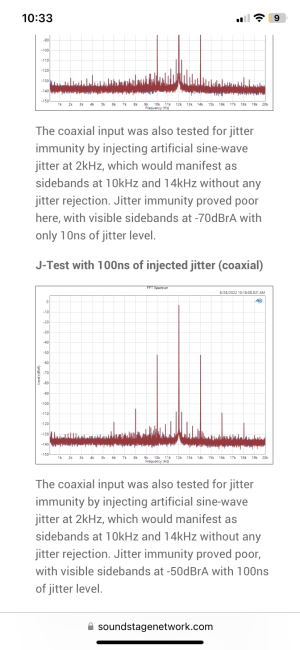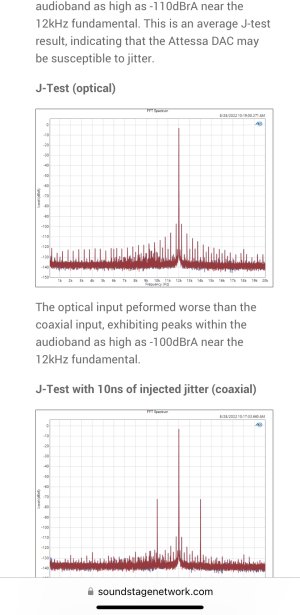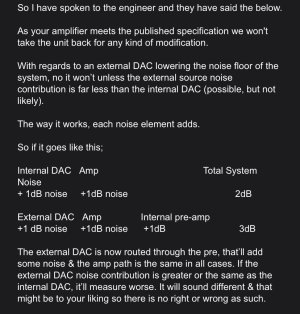You are using an out of date browser. It may not display this or other websites correctly.
You should upgrade or use an alternative browser.
You should upgrade or use an alternative browser.
WiiM Pro vs Pro Plus
- Thread starter xed
- Start date
Matias
Major Contributor
Look at the jitter graphs for Toslink and Coax below, there is not much to improve on a bit perfect signal with lowest jitter.

 www.audiosciencereview.com
www.audiosciencereview.com

WiiM Pro - Review & Measurements (Streamer)
WiiM Pro - Review & Measurements Hey folks, It is time for my first review of 2023... This one is about a complete objective analysis of the new WiiM Pro streamer. The aforementioned has been recently announced, back in November 2022, and I can see quite a strong hype around it since. That...
 www.audiosciencereview.com
www.audiosciencereview.com
These tests won't tell too much about the jitter coming from the device when it's connected to DACs like ADI-2.Look at the jitter graphs for Toslink and Coax below, there is not much to improve on a bit perfect signal with lowest jitter.

WiiM Pro - Review & Measurements (Streamer)
WiiM Pro - Review & Measurements Hey folks, It is time for my first review of 2023... This one is about a complete objective analysis of the new WiiM Pro streamer. The aforementioned has been recently announced, back in November 2022, and I can see quite a strong hype around it since. That...www.audiosciencereview.com
steadyshot
Major Contributor
- Joined
- Mar 14, 2023
- Messages
- 723
I would like to know also if there are some design changes - galvanic isolation on coax out etc… Probably not but not answered officially. For instance I cannot find in the manual of my integrated if coax in is isolated so I want this somewhere on the chain since I want to use coax for 192k output in my dac
Last edited:
Matias
Major Contributor
Exactly. Looking at digital output alone it is already excellent (side bands below -155 dB), and when entering the DAC and going out as analog, it should be even more irrelevant/inaudible. As I was trying to point out: if the digital output is already excellent, the analog after the DAC more so, so how would the Pro Plus improve from that?These tests won't tell too much about the jitter coming from the device when it's connected to DACs like ADI-2.
Well, not exactly. For example, you would observe the same excellent quality of the Mini digital output and of the Pro output when both are connected to ADI-2, but it does not mean that both devices can produce signal of the same quality.Exactly. Looking at digital output alone it is already excellent (side bands below -155 dB), and when entering the DAC and going out as analog, it should be even more irrelevant/inaudible. As I was trying to point out: if the digital output is already excellent, the analog after the DAC more so, so how would the Pro Plus improve from that?
There is no point in evaluating the problems that your instrument eliminates at the same time.
steadyshot
Major Contributor
- Joined
- Mar 14, 2023
- Messages
- 723
My internal dac does not reject jitter and I cannot add an external dac because I will worsen the snr - since my dac signal goes directly to the power amp section of my integrated - shorter path is preferred. External dac goes through the pre amp stage first. Either have optical with more more jitter input to my dac and up to 96k or coaxial with significant less jitter dac side but maybe more noisy and up to 192kLook at the jitter graphs for Toslink and Coax below, there is not much to improve on a bit perfect signal with lowest jitter.

WiiM Pro - Review & Measurements (Streamer)
WiiM Pro - Review & Measurements Hey folks, It is time for my first review of 2023... This one is about a complete objective analysis of the new WiiM Pro streamer. The aforementioned has been recently announced, back in November 2022, and I can see quite a strong hype around it since. That...www.audiosciencereview.com
Last edited:
How did you deduce it?My internal dac does not reject jitter
And this and that?Either have optical with more more jitter input to my dac and up to 96k or coaxial with significant less jitter dac side but maybe more noisy and up to 192k
Mr Ee
Major Contributor
I think you're worrying far too much about Roksan's additive noise comment.My internal dac does not reject jitter and I cannot add an external dac because I will worsen the snr - since my dac signal goes directly to the power amp section of my integrated - shorter path is preferred. External dac goes through the pre amp stage first. Either have optical with more more jitter input to my dac and up to 96k or coaxial with significant less jitter dac side but maybe more noisy and up to 192k
Do you have 1m speaker cables...?
VintageFlanker
Senior Member
- Joined
- Jun 8, 2023
- Messages
- 46
Why keep asking when WiiM themselves said that there's no change on the digital part?
steadyshot
Major Contributor
- Joined
- Mar 14, 2023
- Messages
- 723
Hi @onlyoneme . Thanks for your response.How did you deduce it?
And this and that?
According to injected jitter j tests on : https://www.soundstagenetwork.com/i...ts&catid=97:amplifier-measurements&Itemid=154
According to specs optical is capped at 24/96.
And roksan response about the dac paths ( in screenshot )
Attachments
steadyshot
Major Contributor
- Joined
- Mar 14, 2023
- Messages
- 723
I have probably did not see the response from WiimWhy keep asking when WiiM themselves said that there's no change on the digital part?
steadyshot
Major Contributor
- Joined
- Mar 14, 2023
- Messages
- 723
2.5m eachI think you're worrying far too much about Roksan's additive noise comment.
Do you have 1m speaker cables...?
Have you also seen this, line in vs digital in?Hi @onlyoneme . Thanks for your response.
According to injected jitter j tests on : https://www.soundstagenetwork.com/i...ts&catid=97:amplifier-measurements&Itemid=154
According to specs optical is capped at 24/96.
And roksan response about the dac paths ( in screenshot )

Brantome
Moderator
Totally as a humorous aside, does it also turn on the red light?I think you're worrying far too much about Roksan's additive noise comment.
Mr Ee
Major Contributor
It can, but it doesn't have to.Totally as a humorous aside, does it also turn on the red light?
steadyshot
Major Contributor
- Joined
- Mar 14, 2023
- Messages
- 723
What can I do about it ?
Similar threads
- Replies
- 41
- Views
- 11K
- Replies
- 15
- Views
- 3K
- Replies
- 391
- Views
- 42K
- Replies
- 11
- Views
- 1K
- Replies
- 9
- Views
- 802





